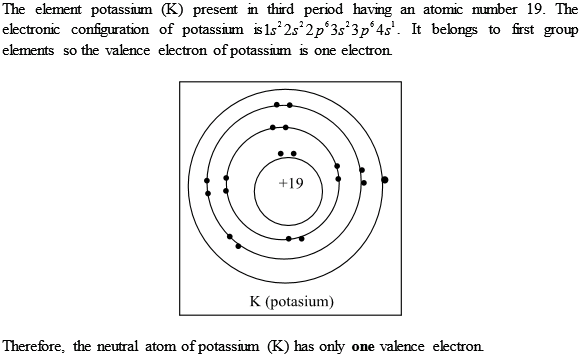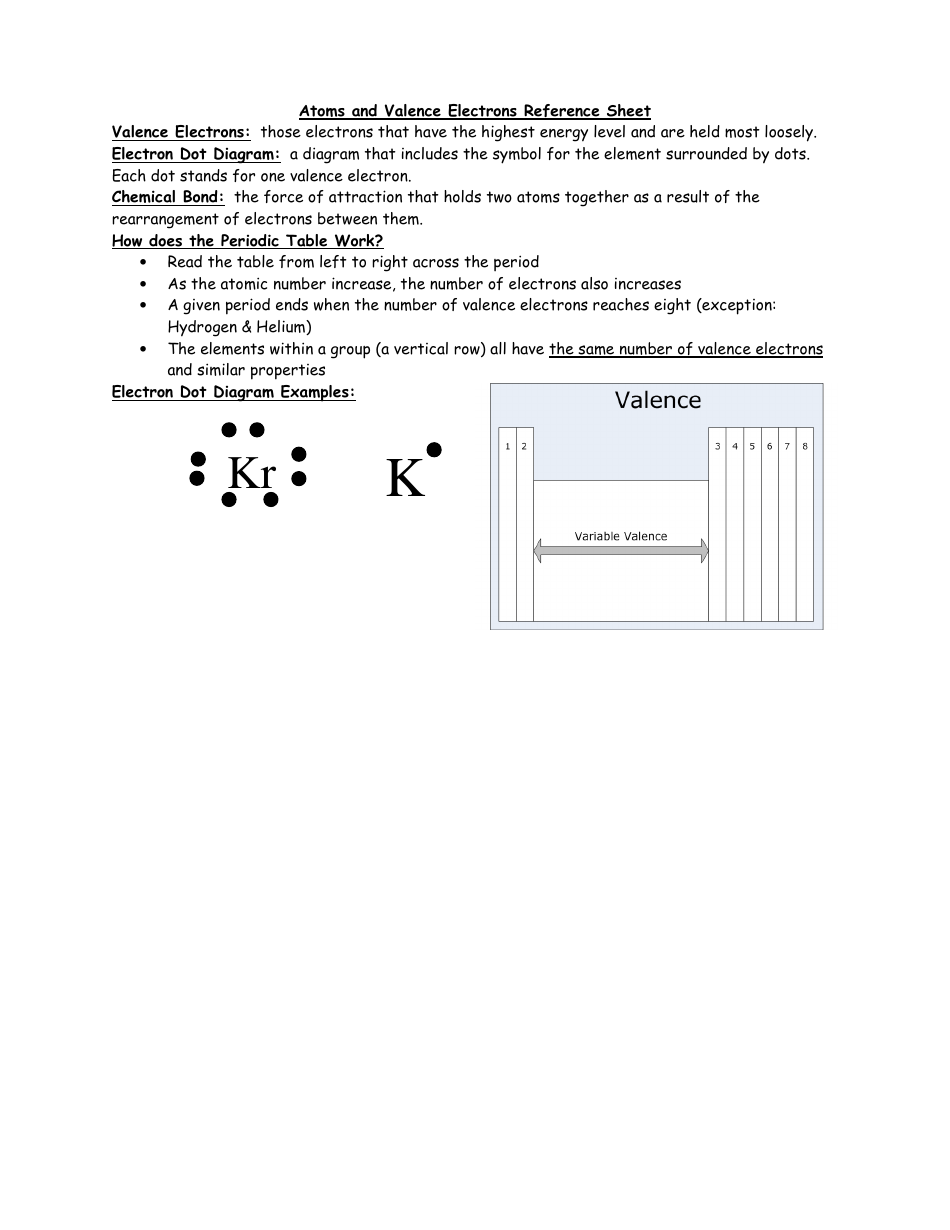K Valence Electrons
Step 4: Find Valence Electrons. The total number of electrons present in the valence shell of an atom are called valence electrons, and there are a total of seven electrons present in the valence shell of chlorine (3s²3p⁵). Thus, chlorine has seven valence electrons. Also Read: Valence Electrons & Valency of Hydrogen (H). View this answer Potassium (K) has 19 total electrons, as indicated by its atomic number (the number of electrons equals the number of protons in a neutral atom).
Covers valence shell electrons and inner shell electrons. The electrons are color-coded to indicate which atoms they belonged to before the covalent bonds formed, with red representing hydrogen and blue representing carbon. Four covalent bonds are formed so that C has an octet of valence electrons, and each H has two valence electrons—one from the carbon atom and one from one of the hydrogen atoms. Potassium atom has 19 electons. Electronic configuration includes - 2,8,8,1. According to the octet rule, the atom or ion to be stable has to have 8 electons in the outermost shell. It's practically impossible for the potassium atom to gain 7 elec.
Element Potassium - K
Comprehensive data on the chemical element Potassium is provided on this page; including scores of properties, element names in many languages, most known nuclides of Potassium. Common chemical compounds are also provided for many elements. In addition technical terms are linked to their definitions and the menu contains links to related articles that are a great aid in one's studies.
K 19 Valence Electrons
Potassium Menu
Valence Electrons Calculator
- Potassium Page One
- Potassium Page Two
- Potassium Page Three
Overview of Potassium
- Atomic Number: 19
- Group: 1
- Period: 4
- Series: Alkali Metals
Potassium's Name in Other Languages
- Latin: Kalium
- Czech: Draslík
- Croatian: Kalij
- French: Potassium
- German: Kalium - s
- Italian: Potassio
- Norwegian: Kalium
- Portuguese: Potássio
- Russian: Калий
- Spanish: Potasio
- Swedish: Kalium
Atomic Structure of Potassium
- Atomic Radius: 2.77Å
- Atomic Volume: 45.46cm3/mol
- Covalent Radius: 2.03Å
- Cross Section (Thermal Neutron Capture) σa/barns: 2.1
- Crystal Structure: Cubic body centered
- Electron Configuration:
- 1s2 2s2p6 3s2p6 4s1
- Electrons per Energy Level: 2,8,8,1
- Shell Model
- Shell Model
- Ionic Radius: 1.38Å
- Filling Orbital: 4s1
- Number of Electrons (with no charge): 19
- Number of Neutrons (most common/stable nuclide): 20
- Number of Protons: 19
- Oxidation States: 1
- Valence Electrons: 4s1
- Electron Dot Model
- Electron Dot Model
Chemical Properties of Potassium


- Electrochemical Equivalent: 1.4587g/amp-hr
- Electron Work Function: 2.3eV
- Electronegativity: 0.82 (Pauling); 0.91 (Allrod Rochow)
- Heat of Fusion: 2.334kJ/mol
- Incompatibilities:
- Ionization Potential
- First: 4.341
- Second: 31.625
- Third: 45.72
- Valence Electron Potential (-eV): 10.4
Physical Properties of Potassium
- Atomic Mass Average: 39.0983
- Boiling Point: 1032K 759°C 1398°F
- Coefficient of lineal thermal expansion/K-1: 83E-6
- Conductivity
- Electrical: 0.139 106/cm Ω
Thermal: 1.024 W/cmK
- Electrical: 0.139 106/cm Ω
- Density: 0.862g/cc @ 300K
- Description:
- Very soft silvery metal that quickly oxidizes to white in air and reacts violently in water.
- Elastic Modulus:
- Bulk: 3.1/GPa
- Rigidity: 1.3/GPa
- Youngs: 3.53/GPa
- Enthalpy of Atomization: 89.5 kJ/mole @ 25°C
- Enthalpy of Fusion: 2.32 kJ/mole
- Enthalpy of Vaporization: 77.5 kJ/mole
- Flammablity Class:
- Freezing Point:see melting point
- Hardness Scale
- Brinell: 0.363 MN m-2
- Mohs: 0.4
- Heat of Vaporization: 79.87kJ/mol
- Melting Point: 336.5K 63.35°C 146.03°F
- Molar Volume: 45.46 cm3/mole
- Physical State (at 20°C & 1atm): Solid
- Specific Heat: 0.75J/gK
- Vapor Pressure = 0.000106Pa@63.35°C
Regulatory / Health

- CAS Number
- 7440-09-7
- RTECS: TS6465000
- OSHAPermissible Exposure Limit (PEL)
- No limits set by OSHA
- OSHA PEL Vacated 1989
- No limits set by OSHA
- NIOSHRecommended Exposure Limit (REL)
- No limits set by NIOSH
- Levels In Humans:
Note: this data represents naturally occuring levels of elements in the typical human, it DOES NOT represent recommended daily allowances.- Blood/mg dm-3: 1620
- Bone/p.p.m: 2100
- Liver/p.p.m: 16000
- Muscle/p.p.m: 16000
- Daily Dietary Intake: 1400-7400 mg
- Total Mass In Avg. 70kg human: 140 g
Who / Where / When / How
- Discoverer: Sir Humphrey Davy
- Discovery Location: London England
- Discovery Year: 1807
- Name Origin:
- From potash (pot ash); K from latin: kalium
- Abundance of Potassium:
- Earth's Crust/p.p.m.: 21000
- Seawater/p.p.m.: N/A
- Atmosphere/p.p.m.: N/A
- Sun (Relative to H=1E12): 145000
- Sources of Potassium:
- Found in minerals like carnallite [(KMgCl3).6H2O], sylvite (KCL) and alunite. Annual world production is around 200 tons. Primary mining areas are in Germany, Spain, Canada, USA and Italy.
- Uses of Potassium:
- Used as potash in making glass, soap, lenses and salt substitute. Also as saltpeter, potassium nitrate (KNO3) it is used to make explosives and to color fireworks in mauve.
- Additional Notes:
- Formerly called kalium hence the symbol 'K'.
Potassium Menu
- Potassium Page One
- Potassium Page Two
- Potassium Page Three
References
Azpen driver download. A list of reference sources used to compile the data provided on our periodic table of elements can be found on the main periodic table page.

Related Resources
- Anatomy of the Atom
Answers many questions regarding the structure of atoms. - Molarity, Molality and Normality
Introduces stoichiometry and explains the differences between molarity, molality and normality. - Molar Mass Calculations and Javascript Calculator
Molar mass calculations are explained and there is a JavaScript calculator to aid calculations. - Chemical Database
This database focuses on the most common chemical compounds used in the home and industry.
Citing this page
If you need to cite this page, you can copy this text:
Kenneth Barbalace. Periodic Table of Elements - Potassium - K. EnvironmentalChemistry.com. 1995 - 2021. Accessed on-line: 4/24/2021
https://EnvironmentalChemistry.com/yogi/periodic/K.html
.

Linking to this page
If you would like to link to this page from your website, blog, etc., copy and paste this link code (in red) and modify it to suit your needs:
<a href='https://EnvironmentalChemistry.com/yogi/periodic/K.html'>echo Periodic Table of Elements: Potassium - K (EnvironmentalChemistry.com)</a>- Comprehensive information for the element Potassium - K is provided by this page including scores of properties, element names in many languages, most known nuclides and technical terms are linked to their definitions.
.
NOTICE: While linking to articles is encouraged, OUR ARTICLES MAY NOT BE COPIED TO OR REPUBLISHED ON ANOTHER WEBSITE UNDER ANY CIRCUMSTANCES.
Megawin driver download for windows 10. PLEASE, if you like an article we published simply link to it on our website do not republish it.
